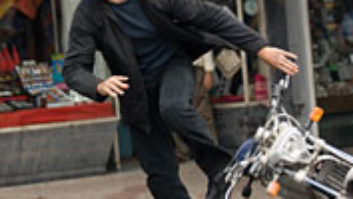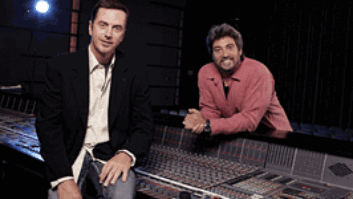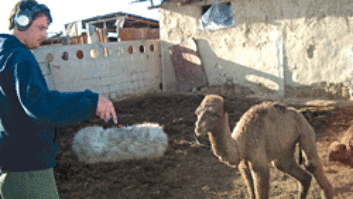In an age where much of what we see in movies and on television has been shot on either a soundstage or in a noisy location, then combined with computer-generated images, Foley recording has become increasingly important as a way to give audiences a sense that what they are seeing is realistic and believable. Great pains are taken to ensure that every nuance, every gesture is re-created and recorded on a Foley stage.
Sometimes it’s not enough just to add door slams, footsteps and a walla session. Modern filming, computer graphics and editing techniques have created a need for more than the usual “see a dog, hear a dog” approach. Morphing is a good example of a (albeit passe) film technique that required a parallel advance in sound design and recording. How do you create the sound of a car morphing into a horse? With all of the creative approaches to getting good sounds, a Foley stage can be the sight of grown men doing seemingly weird things, like sucking and licking their wrists (Foley for the Playboy Channel) or walking in size 12 pumps with their Speedos on (footsteps for a woman in a mini-skirt).
The Foley stage is probably the single most effective design tool available today, according to supervising sound editor Wylie Stateman of Soundelux, Hollywood. “It’s much faster to do a track in real time to picture of a man handling a doorknob or opening and closing a door or dresser or cabinet than it is to search for the appropriate sound effect in a library and brute-force editing it into sync with the picture,” he says.
“There are often little nuances that the actor brought to the way they did something that may not have been captured in a library recording of that same sound,” adds Mike Ruschak, a Foley recordist and mixer at Sync Sound in New York. “There are some sounds that you can’t find in a library. Somebody pouring a bowl of Cornflakes—you may not have that, specifically. We used to do a show called Monsters, and we needed the sound of a mummy ripping the heart from a living person. That’s something you don’t normally have in your library. So we’d go out and get a watermelon and cut it open and take a piece of calf heart or something and pull it in and out a few times, and then pitch it up or down.”
Sometimes a low Foley budget can call for drastic measures. Ruschak recalls working on Bellevue Emergency, a reality-based trauma program for TV. The producer wanted lots of off-camera sounds to convey the sense that it was the busiest hospital in the world. Because of time and budget restraints, they only had four hours booked to do Foley for a half-hour show. “We needed the sounds of people working with hemostats, stretching gloves and clanging surgical instruments,” recalls Ruschak, “so what we did was set up three microphones and got a number of props that we set up as different stations. On one, we had hemostats and scalpels and a couple of soft things that we could cut, and on the other station we had nonmetallic things like gloves and gowns. In the middle of all this, we had a shotgun mic down on the ground beside a gurney. Since it was all off-camera, nothing was really hard and fast, but it gave me in the mix an extra layer of texture of all kinds of stuff, and it took almost no time to do, other than a real-time pass through the show.”
Stateman says that two of the cutting-edge areas in Foley today are multiple miking and the Foley artist vocalizing a human sound combined with a physical noise to produce a sound with an interesting contour. “We do a lot of sounds for scene transitions from picture cuts,” he explains. “There’s a term that we use called a ‘staggerly,’ that was coined by sound designer Sandy Berman. A staggerly is a sound effect that’s created for some kind of camera move like a whip pan, an undercranked camera or an optically printed shot. It’s like taking a single sound and staggering it or smearing it across the image, in a way that relates sonically to the visual effect. These are sounds that you haven’t heard before that sometimes require the orchestration of several people and various pieces of outboard equipment.”
To create a staggerly often requires two Foley walkers, an engineer, a recordist and maybe even a fifth person cranking knobs on real-time harmonizers. “We use this technique all the time in Oliver Stone’s films for scene transitions or strange camera angles,” he says. “Natural Born Killers was a mosaic of layered, abstract sounds, many of which were created on the Foley stage. Just a simple ‘aahhh’ sound thrown together with the sound of a tennis racket being swung creates a really sensual, dynamically moving transition sound.” Stateman warns about getting too many layers of sounds that become lost in the milieu. To be economical with these is the key, he says, so as not to lose the abstract realism of the newly created sounds.
Although different engineers prefer different mics for different applications, both Ruschak and Stateman agree that multiple miking is usually the way to go to achieve good recordings with lots of dynamics and ambience. Using tube microphones, as well, helps to smooth out the harsh transients of sounds like cocking a gun or breaking glass. A lot of the recordings made now on the Foley stage are digital, so having a very warm-sounding tube microphone is a great advantage in taking away some of that harshness. Soundelux built its own microphone for Foley and recording purposes, which they call the U95. “It’s a large-diaphragm microphone with very robust audio components,” reveals Stateman. “It has a huge power supply so that it has very strong low-frequency response, and very low noise. It was the microphone we had always wanted but was only available at a huge price. There a lot of vintage microphones that are excellent for Foley.”
“We have a very quiet room,” says Ruschak, “and we mike things maybe a foot farther away than people might in other studios. Then the Foley walker can re-create the dynamics of walking, whether they’re a drunk staggering and they’re fairly light on their feet, or they’re Nazis marching and he really has to pound. We try to vary the mic placement and the performance for each one of those, rather than taking a generic footstep from a library.
“We have a Sanken CU41 that we like to use. The reason we picked it over other mics is that even with a medium or short capsule on a shotgun mic, you still get this really tight pattern, a really tight pickup of the thing that you’re recording, and we wanted more air between the Foley and the microphone, for lack of a better word. The Sanken is like a Neumann 87, only it has higher pickup off-axis. So if the Foley artist isn’t quite exactly in the sweet spot, it still has a really good pickup with a high rejection of extraneous noise. This gives us a little more latitude in a recording session.”
Foley engineers have gone to great lengths to re-create sounds in a Foley environment, whether by bringing huge airplane wings and parts onto the stage for Alive or True Lies, or constructing a seven-ton rock mountain for Cliffhanger. Stateman warns that building an exact replica of what you think you need may not be the only solution. “The single most important productive element,” he says, “is an excellent Foley team that knows the acoustics of the room and knows how to get the most dynamic range from their signal path, and the most variety of dynamic range. That’s why recording with multiple microphones is such an effective thing.
“Foley is the glue that holds the sound effects together with the dialog,” Stateman concludes. “Especially with looped dialog, the Foley wraps around the dialog and gives you a very clear sense of reality. With Foley, if it’s recorded and performed properly it integrates into a production sequence. If it’s recorded too close-up, or with inappropriate equipment or room acoustics, or poor recording techniques, then it seems to sit on top of the soundtrack instead of integrating. At that point, no amount of equalizing or adding reverb on the re-recording stage is going to help much. If it’s done by a team that really understands the nuances of ambient miking techniques, then you end up with material that really supports the production track or wraps around the ADR and makes it real.”



